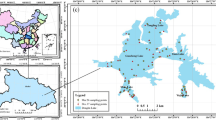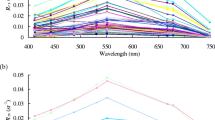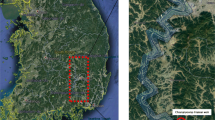Abstract
Complex optical properties, such as non-pigment suspension and colored dissolved organic matter (CDOM), make it difficult to achieve accurate estimations of remotely sensed chlorophyll a (Chla) content of inland turbidity. Recent attempts have been made to estimate Chla based on red and near-infrared regions where non-pigment suspension and CDOM have little effect on water reflectance. The objective of this study is to validate the applicability of WV-2 imagery with existing effective estimation methods from MERIS when estimating Chla content in inland turbidity waters. The correlation analysis of measured Chla content and WV-2 imagery bands shows that the Chla sensitive bands of WV-2 are red edge, NIR 1, and NIR 2. The coastal band is designed for seawater Chla detection. However, the high correlation with turbidity data and low correlation with Chla made coastal band unsuitable for estimating Chla in inland waters. The high-resolution water body images were extracted by combining the spectral products (NDWI) with the spatial morphological products (sobel edge detection). The estimation results show that the accuracy of the single band and NDCI is not as good as the two-band method, three-band method, stepwise regression algorithm (SRA) and support vector machines (SVM). The SVM estimation accuracy was the highest with an R2, RMSE, and URMSE of 0.8387, 0.4714, and 19.11%, respectively. This study demonstrates that the two-band and three-band methods are effective for estimating Chla in inland water for WV-2 imagery. As a high-precision estimation method, SVM has great potential for inland turbidity water Chla estimation.













Similar content being viewed by others
References
Chang, C. C., & Lin, C. J. (2011). LIBSVM: A library for support vector machines. ACM, 2(3), 1–27. https://doi.org/10.1145/1961189.1961199.
Chen, Y., Shi, R., Shu, S., & Gao, W. (2013). Ensemble and enhanced pm 10, concentration forecast model based on stepwise regression and wavelet analysis. Atmospheric Environment, 74(74), 346–359. https://doi.org/10.1016/j.atmosenv.2013.04.002.
Dall'Olmo, G., & Gitelson, A. A. (2005). Effect of bio-optical parameter variability on the remote estimation of chlorophyll-a concentration in turbid productive waters: Experimental results. Applied Optics, 44(3), 412–422. https://doi.org/10.1364/AO.44.000412.
Dall'Olmo, G., & Gitelson, A. A. (2006). Effect of bio-optical parameter variability and uncertainties in reflectance measurements on the remote estimation of chlorophyll-a concentration in turbid productive waters: Modeling results. Applied Optics, 45(15), 3577–3592. https://doi.org/10.1364/AO.45.003577.
Dall'Olmo, G., Gitelson, A. A., Rundquist, D. C., Leavitt, B., Barrow, T., & Holz, J. C. (2005). Assessing the potential of seawifs and modis for estimating chlorophyll concentration in turbid productive waters using red and near-infrared bands. Remote Sensing of Environment, 96(2), 176–187. https://doi.org/10.1016/j.rse.2005.02.007.
DigitalGlobe (2009). The benefits of the 8 spectral bands of WorldView-2. http://worldview2.digitalglobe.com/docs/WorldView-2_8Band_Applications_Whitepaper.pdf. Accessed 20 July 2011.
Duan, H., Lei, Y. U., Zhang, B., Liu, D., & Song, K. (2006). Hyperspectral data applied in monitoring and evaluating the water trophic state of Lake Chagan. Acta Scientiae Circumstantiae, 26(7), 1219–1226.
Gitelson, A. (1992). The peak near 700 nm on radiance spectra of algae and water: Relationships of its magnitude and position with chlorophyll concentration. International Journal of Remote Sensing, 13, 3367–3373. https://doi.org/10.1080/01431169208904125.
Gitelson, A. A., Dall'Olmo, G., Moses, W., Rundquist, D. C., Barrow, T., Fisher, T. R., Gurlin, D., & Holz, J. (2008). A simple semi-analytical model for remote estimation of chlorophyll- a, in turbid waters: Validation. Remote Sensing of Environment, 112(9), 3582–3593. https://doi.org/10.1016/j.rse.2008.04.015.
Gons, H. J. (1999). Optical teledetection of chlorophyll a in turbid inland waters. Environmental Science & Technology, 33(7), 1127–1132. https://doi.org/10.1021/es9809657.
Gons, H. J., Rijkeboer, M., & Ruddick, K. G. (2005). Effect of a waveband shift on chlorophyll retrieval from meris imagery of inland and coastal waters. Journal of Plankton Research, 27(1), 125–127. https://doi.org/10.1093/plankt/fbh151.
Goodin, D. G., Han, L., Fraser, R. N., Rundquist, D. C., Stebbins, W. A., & Schalles, J. F. (1993). Analysis of suspended solids in water using remotely sensed high resolution derivative spectra. Photogrammetric Engineering & Remote Sensing, 59(4), 505–510.
Gordon, H. R., & Morel, A. Y. (1983). Remote assessment of ocean color for interpretation of satellite visible imagery. Physics of the Earth & Planetary Interiors, 37(4), 292. https://doi.org/10.1016/0031-9201(85)90018-4.
Han, L. H., & Rundquist, D. C. (1997). Comparison of NIR/RED ratio and first derivative of reflectance in estimating algal-chlorophyll concentration: A case study in a turbid reservoir. Remote Sensing of Environment, 62, 253–261. https://doi.org/10.1016/S0034-4257(97)00106-5.
Hooker, S. B., Lazin, G., Zibordi, G., & Mclean, S. (2002). An evaluation of above- and in-water methods for determining water-leaving radiances. Journal of Atmospheric & Oceanic Technology, 19(4), 486–515. https://doi.org/10.1175/1520-0426(2002)019<0486:AEOAAI>2.0.CO;2.
Jiao, H. B., Zha, Y., Gao, J., Li, Y. M., Wei, Y. C., & Huang, J. Z. (2006). Estimation of chlorophyll-a concentration in Lake Tai, China using in situ hyperspectral data. International Journal of Remote Sensing, 27(19), 4267–4276. https://doi.org/10.1080/01431160600702434.
Kirk, J. T. O. (1994). Light and photosynthesis in aquatic ecosystems, 2nd Edition [M]. Cambridge: Cambridge University Press.
Laben, C. A., & Brower, B. V. (2000). Process for enhancing the spatial resolution of multispectral imagery using pan-sharpening. Websterny Uspenfieldny Us.
Le, C., Hu, C., Cannizzaro, J., English, D., Muller-Karger, F., & Lee, Z. (2013). Evaluation of chlorophyll-a remote sensing algorithm for an optically complex estuary. Remote Sensing of Environment, 129(2), 75–89. https://doi.org/10.1016/j.rse.2012.11.001.
Le, C. F., Li, Y. M., Yong, Z., Sun, D. Y., Huang, C. C., & Lu, H. (2009). A four-band semi-analytical model for estimating chlorophyll a in highly turbid lakes: The case of Taihu Lake, China. Remote Sensing of Environment, 113(6), 1175–1182. https://doi.org/10.1016/j.rse.2009.02.005.
Lin, C., Wu, C. C., Tsogt, K., Ouyang, Y. C., & Chang, C. I. (2015). Effects of atmospheric correction and pansharpening on LULC classification accuracy using WorldView-2 imagery. Information Processing in Agriculture, 2(1), 25–36. https://doi.org/10.1016/j.inpa.2015.01.003.
Manakos, I., Manevski, K., Kalaitzidis, C., & Edler, D. (2011). Comparison between FLAASH & ATCOR atmospheric correction modules on the basis of WorldView-2 imagery and in situ spectroradiometric measurements. Earsel, Sig-Imaging Spectroscopy Workshop.
Mcfeeters, S. K. (1996). The use of the normalized difference water index (ndwi) in the delineation of open water features. International Journal of Remote Sensing, 17(7), 1425–1432. https://doi.org/10.1080/01431169608948714.
Mishra, S., & Mishra, D. R. (2012). Normalized difference chlorophyll index: A novel model for remote estimation of chlorophyll- a, concentration in turbid productive waters. Remote Sensing of Environment, 117(2), 394–406. https://doi.org/10.1016/j.rse.2011.10.016.
Mobley, C. D. (1994). Light and water: Radiative transfer in natural waters. Academic Press.
O'Reilly, J. E., Maritorena, S., Mitchell, B. G., Siegel, D. A., Carder, K. L., Garver, S. A., Kahru, M., & McClain, C. (1998). Ocean color chlorophyll algorithms for seawifs. Journal of Geophysical Research Oceans, 103(C11), 24937–24953. https://doi.org/10.1029/98JC02160.
Pu, R., & Landry, S. (2012). A comparative analysis of high spatial resolution IKONOS and WorldView-2 imagery for mapping urban tree species. Remote Sensing of Environment, 124(9), 516–533. https://doi.org/10.1016/j.rse.2012.06.011.
Schalles, J. F. (2006). Optical remote sensing techniques to estimate phytoplankton chlorophyll a concentrations in coastal. Remote sensing of aquatic coastal ecosystem processes.
Sun, D. Y., Li, Y. M., & Qiao, W. (2009). A unified model for remotely estimating chlorophyll a in Lake Taihu, China, based on SVM and in situ hyperspectral data. IEEE Transactions on Geoscience & Remote Sensing, 47(8), 2957–2965. https://doi.org/10.1109/TGRS.2009.2014688.
Tang, J., Tian, G., Wang, X., Wang, X., & Song, Q. (2004). The methods of water spectra measurement and analysis I: Above-water method. Journal of Remote Sensing, (01):37–44.
Vapnik, V. (1996). Support vector method for function approximation, regression estimation, and signal processing. Advances in Neural Information Processing Systems, 9, 281–287.
Wang, J. (2013). Pearson correlation coefficient. Springer New York, Pearson Correlation Coefficient.
Wang, X. L., Zhou, Z. Y., & Yan, J. P. (2009). Apply GA-SVM to retrieve water quality parameters of Weihe River from multispectral remote sensing data. Journal of Remote Sensing, 13(4), 735–744.
Yacobi, Y. Z., Moses, W. J., Kaganovsky, S., Sulimani, B., Leavitt, B. C., & Gitelson, A. A. (2011). Nir-red reflectance-based algorithms for chlorophyll- a, estimation in mesotrophic inland and coastal waters: Lake Kinneret case study. Water Research, 45(7), 2428–2436. https://doi.org/10.1016/j.watres.2011.02.002.
Zhang, Y., Ma, R., Duan, H., Loiselle, S., Zhang, M., & Xu, J. (2016). A novel MODIS algorithm to estimate chlorophyll a concentration in eutrophic turbid lakes. Ecological Indicators, 69, 138–151. https://doi.org/10.1016/j.ecolind.2016.04.020.
Zhen, Z., Gong, Z. N., & Zhao, W. J. (2012). Analysis of hydrophytes for spatial evolution pattern in Guanting Reservoir, China. Journal of Agro-Environment Science, 31(8), 1586–1595.
Zhou, Y., Zhou, W. Q., Wang, S. X., & Zhang, P. (2004). Applications of remote sensing techniques to inland water quality monitoring. Advances in Water Science, 15(3), 312–317.
Zhu, X., Zhang, H., Lei, P., Zhang, B., Shan, B., & Shi, M. (2015). Historical distribution characteristics of major elements in Guanting Reservoir sediment. Huanjing Kexue Xuebao 36(2). https://doi.org/10.13671/j.hjkxxb.2015.0475.
Funding
This research was financially supported by the International Science & Technology Cooperation Program of China (Grant no.2014DFA21620).
Author information
Authors and Affiliations
Corresponding author
Rights and permissions
About this article
Cite this article
Wang, X., Gong, Z. & Pu, R. Estimation of chlorophyll a content in inland turbidity waters using WorldView-2 imagery: a case study of the Guanting Reservoir, Beijing, China. Environ Monit Assess 190, 620 (2018). https://doi.org/10.1007/s10661-018-6978-7
Received:
Accepted:
Published:
DOI: https://doi.org/10.1007/s10661-018-6978-7




